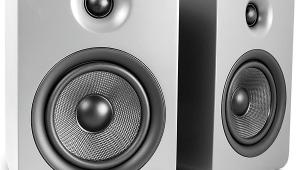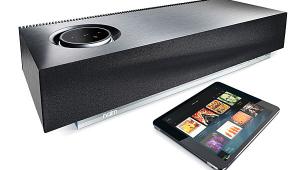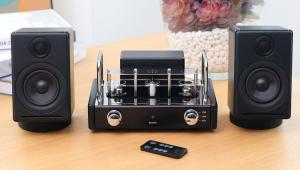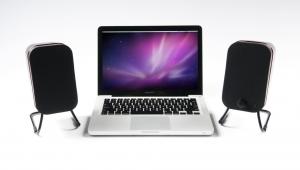Monitor Audio i-deck
Shortly after Steve Jobs became a music mogul, the iPod became something of a home audio server. This brilliant left turn has made everyone's favorite white object of desire a doubly useful device that entertains whether you're at home or on the go. Although a Mac is something of a technological island unto itself, the iPod is a more pragmatic creature. It's on speaking terms with not only—shock, horror!—Windows PCs, but with a variety of other devices, from staid-black surround receivers, to far-flung multizone empires, to slick standalone compact systems like Monitor Audio's i-deck.

The British-accented i-deck is a two-channel minisystem that provides easy docking for an iPod. With a central module flanked by two visually complementary speakers, it looks as though it might have sprouted from an iPod—and, in a sense, it has. Of course, Monitor Audio is merely an admirer of Apple, not a subsidiary. The control module contains the dock, a rated 18 watts per channel of amplification, and a blue LED so bright you could read by it. Viewed from the side with all its front surfaces inclined backward, the system looks like a series of trapezoidal sculptures.
Supplied necessities include a large external power supply, solder-tipped cables that slip easily into wire-clip speaker terminals, and a thin remote control with volume and transport-control keys. There is no scroll wheel on the remote, but you may perform any chores that require interaction with the iPod interface before docking.
The rear panel includes a multipin jack that accepts iPod's proprietary patch cord. That allows the system to transfer music directly from your Mac or PC when the iPod is docked. Also on the back is a 0.125-inch minijack that uses a supplied interconnect cable to patch the headphone outputs of non-iPod devices into the system. While that's not as elegant as using your iPod with the i-deck, it's nice to have the option to add, say, a radio, or something else that falls outside the Apple domain.
Interchangeable angled panels of gray plastic adapt various iPod models to the multipin male connector at the bottom of the docking area. Installing the panel is easy—it clicks into place and is not easily dislodged. Whether you've got an iPod Mini, iPod Photo, a third-generation unit, or a fourth-generation unit, the i-deck has a panel for your baby. Got the iPod nano? A compatible panel is on the way. First- and second-generation iPods without the now-standard 30-pin connector must use the analog input in the back.
You can literally drop the iPod into the dock. After the first few docking maneuvers, you needn't even push it into place. It just goes right in, and, if it was playing before docking, it keeps on playing after docking. That makes it easy to pick a playlist, hit start, dock, and start ransacking the fridge. When the music stops—after all, we all have to allocate time for other necessities, like watching television—the battery will quietly charge itself for tomorrow morning's hellish commute.
Although its fit and finish are pleasing, the system is constructed of lightweight molded plastic. You might accept this limitation as a virtue and move the system around as needed. You might tuck the controller, speakers, and power supply under one arm while you use the other one to carry a six-pack out onto the patio. If I had a patio, I certainly would have done that.
If this were no more than an amiable minisystem with an iPod dock, we wouldn't have bothered to review it, but Monitor Audio puts their high-end chops to good use with the i-deck. At that magic moment when player meets docking connector, a profound event quietly occurs: Monitor's digital-to-analog converters take over from Apple's, and the player feeds a digital bitstream to the i-deck.
This end run results in greater clarity and the difference is not subtle. Now look, I'm no iPod purist. I have a whole bunch of portable audio players, and some of them I truly love, including a 6-gigabyte Archos Jukebox that's taken me to Europe and back several times and an MSI SD-memory player with a beautiful color OLED. While they sound fine with headphones in a noisy environment, their puny analog preamp circuitry limits their performance with my higher-resolution music systems, and, for that reason, I've given up using them at home. The iPod's analog circuitry is subject to the same limitation—there's only so much fidelity you're likely to get out of a miniaturized headphone output.
When fed through the player's docking jack, the i-deck bypasses the player's headphone jack. Even with 18 watts per channel feeding molded-plastic-enclosed speakers, you can hear the difference. The headphone-out's veiling effect is conspicuous by its absence. It's a bit like putting tap water through a filter pitcher. The taste is better because of what isn't there.
It was easy to verify the difference. While Linda Thompson's Fashionably Late played on my iPod, I pulled the device out of the dock and connected its headphone output to the auxiliary analog input in back of the system. High-frequency detail all but vanished, the midrange lost much of its presence, the soundstage collapsed, and the genetic vocal blend of Linda and her children Kamila and Teddy lost its luster. It didn't sound bad exactly, just not nearly as clear as before.
With the iPod docked, the system reproduced the harmonic architecture of a sensuous piano recording—the Debussy Preludes as performed by Paul Jacobs—without letting the left-hand part roll off into nothingness. It did well with violin, cello, and piano on the Golub/Kaplan/Carr performance of Rachmaninoff's Trios légiaque. The strings were vivid well into the presence region while retaining the smoothness of this excellent recording.
On Robyn Hitchcock's Spooked, the i-deck delivered the singer's distinctively adenoidal voice, the gold dome tweeter emphasizing his enunciation without excessive sibilance or spittiness. (You've got to love a guy who addresses television as though it were a lover and throws out lines like, "You're the devil's fishbowl, honey.") Bass-guitar lines were fully intelligible but demonstrated a de-emphasis of the bottom string that's not surprising in a small system. The i-deck is rated at –3 decibels down at 75 hertz.
I happen to like compact systems. They take music places where it couldn't otherwise go, including my kitchen—and I've listened to a lot of them. This one has the familiar compression and edginess at high volumes. It seems to have been voiced to work best at low to moderate volumes. At a conversational level, its performance is way above average.
Incidentally, all of my demo tracks were MP3s that I dragged onto the iPod from a PC running Windows XP (so shoot me). As the owner of 1,600 CDs and some obscenely incalculable number of LPs, I tend to roll my own, and I'm expecting my Good Citizen Award from the music industry any day now. I ripped every track at either 160 kilobits per second with Musicmatch or 192 kbps with Windows Media Player 10, the first version to encode MP3 without a plug-in. On my six-month-old IBM PC, it does so at blinding speed.
Altogether, the i-deck is an excellent way to keep your iPod going at home. It won't play extremely loud, process signals in surround, or fling music throughout the home in a multizone system. But it will continue a musical conversation begun during your commute without missing a beat, and it's a lot less awkward than booting up a PC (or even a Mac) just to play music. Monitor Audio has successfully reinvented the compact audio system.
Highlights
• Turn your iPod into a home audio server of sorts with this sleek minisystem
• Drop your iPod in the dock, and it'll keep playing (and recharge)
• Fits iPod 3G, 4G, Mini, Photo, and nano
- Log in or register to post comments





























































